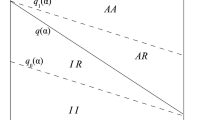Abstract
The paper addresses the question, how policy decisions under uncertainty depend on the underlying welfare concept. We study three different welfare measures: The first is directly based on the ex ante (expected) utility of a representative consumer whereas the second relies on an ex ante and the third on an ex post valuation of policy changes compared to the status quo. We show that decisions based on these measures coincide if and only if risk-neutral expected utility maximization is applied. Differences between the decisions are analyzed for both, risk-averse expected utility maximization and the MaxiMin criterion. For risk-averse decision makers, differences between the first and the second concept arise if the absolute risk-aversion of the decision maker is not constant in income. For risk-aversion and the MaxiMin criterion, the effort levels to provide a public good based on an optimization of ex post utility changes exceed those based on the first or second concept. Implications for environmental policy decisions based on the concepts of abatement costs and benefits from abatement are discussed.
Similar content being viewed by others
REFERENCES
Bishop, R.C. (1986), Resource valuation under uncertainty: Principles for empirical research, in: Smith, V.K. (ed.), Advances in Applied Microeconomics, Vol. 4, Jai Press, Greenwich CT, pp. 133-152.
Eismont, O. and Welsch, H. (1996), Optimal greenhouse gas emissions under various assessments of climate change ambiguity, Environmental and Resource Economics 8: 129-140.
Graham, D.A. (1981), Cost benefit analysis under uncertainty, American Economic Review 71: 715-725.
Hanley, N. and Spash, C.L. (1995), Cost-Benefit Analysis and the Environment, Edward Elgar, Aldershot.
Meier, C.E. and Randall, A. (1991), Use value under uncertainty: Is there a ‘correct’ measure?, Land Economics 67: 378-389.
Ready, R. (1995), Environmental valuation under uncertainty, in: Bromley, D.W. (ed.) The Handbook of Environmental Economics, Blackwell, Oxford, pp. 568-593.
Ulph, A. and Ulph, D. (1997), Global warming, irreversibility and learning, The Economic Journal, 636-650.
Welsch, H. (1995), Greenhouse gas abatement under ambiguity, Energy Economics 17: 91-100.
Author information
Authors and Affiliations
Corresponding author
Rights and permissions
About this article
Cite this article
Lange, A. A note on decisions under uncertainty: the impact of the choice of the welfare measure. Theory and Decision 51, 51–71 (2001). https://doi.org/10.1023/A:1012498106199
Issue Date:
DOI: https://doi.org/10.1023/A:1012498106199




